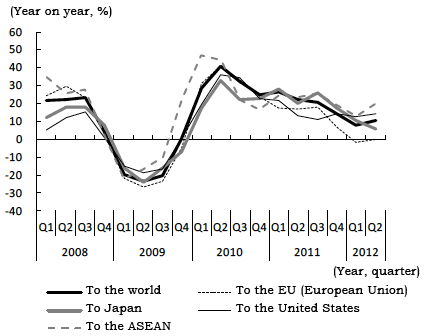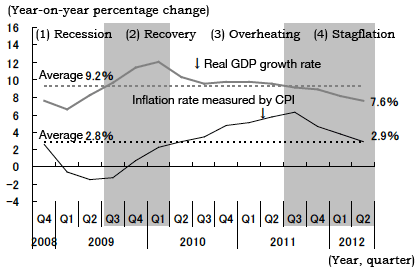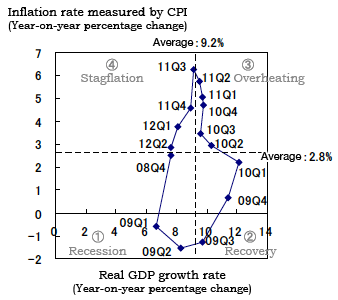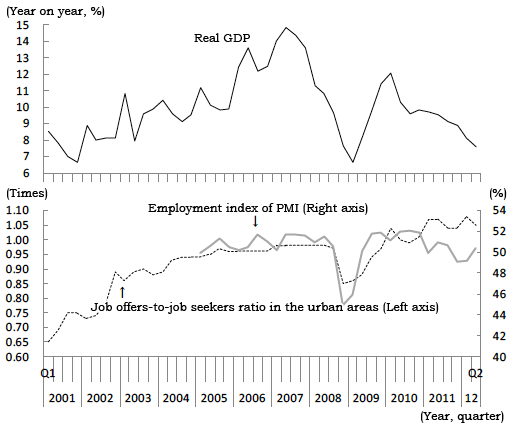China's real GDP growth rate in the second quarter of 2012 was 7.6%, its lowest level since the first quarter of 2009 (when it was 6.6% year on year). However, in contrast to the recession that followed the collapse of Lehman Brothers three years ago, no serious employment problem has arisen this time. This suggests that the lower growth rate may reflect not only the short-term factor of weak demand, but also the medium- and long-term factor of a lower potential growth rate associated with changes in the supply side.
Background to decelerating growth
Real GDP growth in the second quarter of 2012 fell further to 7.6% from 8.1% in the first quarter. This is not only significantly below the 12.1% at its peak in the first quarter of 2010, but also nowhere near the average growth rate of 9.2% that followed Lehman Brother's collapse. Weak demand domestically and overseas can be cited as a short-term factor for the lower growth rate.
In particular, as a result of government policies to contain the real estate bubble, which were announced in succession from 2010 onward, the rate of increase in housing prices has slowed, and growth in real estate investments decelerated substantially, from 27.9% last year to 16.6% in the January to June period of this year. Also, responding to the worldwide economic slowdown, growth in exports from China is also slowing. In particular, exports to Europe where the debt crisis deteriorated have remained below the previous year's level (Figure 1). Nevertheless, compared with the situation in the first half of 2009, when exports to all major markets fell substantially following the Lehman Brothers collapse, the effect is rather muted this time, as exports to countries and regions other than Europe remain relatively solid.
As the economy is heading downwards, inflation is falling. The rate of increase in CPI (year on year) fell to 2.2% in June of this year, from a peak of 6.5% in July of last year. Since it is a lagging indicator of the economic growth rate, the inflation rate is likely to keep falling for the foreseeable future, reflecting the slower growth rate in recent years.
Economic growth rate expected to pick up in the latter half of this year
Given that the inflation rate is a lagging indicator of the economic growth rate, the economy can be divided into the following four phases, depending on whether the growth and inflation rates are higher or lower than their respective reference values: (1) a recession phase, with low growth and low inflation; (2) a recovery phase, with high growth and low inflation; (3) an overheating phase, with high growth and high inflation; and (4) a stagflation phase, with low growth and high inflation (Figure 2).
Change in GDP Growth and Inflation Rates

If we set the average growth rate (9.2%) and the average inflation rate since the Lehman collapse (2.8%) (the fourth quarter of 2008 through the second quarter of 2012) as the reference values, the Chinese economy has been in (4) a stagflation phase since the third quarter of 2011, after going through (1) a recession phase (the fourth quarter of 2008 through the second quarter of 2009), (2) a recovery phase (the third quarter of 2009 through the first quarter of 2010), and (3) an overheating phase (the second quarter of 2010 through the second quarter of 2011). Judging by the growth rate of 7.6% and the inflation rate of 2.9% in the second quarter of 2012, it can be said that the stagflation phase is continuing. Looking at the monthly data, however, the inflation rate in June (2.2%) was already lower than the average inflation rate of 2.8%, suggesting that the Chinese economy has effectively already entered a recession with low growth and low inflation.
This business cycle forms a counterclockwise circle in the plane of coordinates with the growth rate as the horizontal axis and the inflation rate as the vertical axis, reflecting the fact that the former moves ahead first while the latter follows with a certain time lag. This circle has just completed a circuit following the Lehman Brothers collapse (Figure 3).

Responding to the decelerating growth and falling inflation, the Chinese government has shifted its macroeconomic stance from tightening to easing. First, in its monetary policy, the reserve requirements have been reduced three times by a total of 1.5 percentage points since December of last year, followed by interest rate cuts for two consecutive months in June and July this year. Fiscal policy has also been expansionary, as indicated by higher growth (year on year) in fiscal spending from 8.0% in April to 17.7% in June. In the wake of these moves, the growth rate is expected to improve in the second half of this year, from a bottom reached in the second quarter. However, given that growth is unlikely to reach the average of 9.2% in the third quarter, the Chinese economy is expected to stay in a recessionary phase with low growth and low inflation, and it looks likely to be some time yet before it enters a recovery phase with high growth and low inflation.
Strong employment conditions despite low growth
In addition to the short-term factor of weak demand, a fall in the potential growth rate also appears to have pushed down the economic growth rate as a medium- and long-term factor. This view is backed by the fact that employment conditions have not deteriorated, despite the significant fall in the growth rate during the economic downturn this time, in contrast to the situation that prevailed in the wake of the Lehman Brothers collapse. At that time, demand for labor dipped significantly, and many migrant workers in urban areas lost their jobs and had to return home. Reflecting this, the job offers-to-job seekers ratio in urban areas (a concept similar to the effective job offer ratio in Japan) and the employment index of the Purchasing Managers' Index (PMI) dropped significantly in the fourth quarter of 2008 (Figure 4). These employment indicators have since been recovering sharply together with the economic recovery, and remained high even after the economy started to slow in 2010.
Generally speaking, the more substantially the GDP growth rate exceeds (falls below) the potential growth rate, the more labor market conditions tighten (ease) and the higher (lower) the job offers-to-job seekers ratio and the employment index of PMI become. Provided that the potential growth rate remains unchanged, labor market conditions should ease, and the job offers-to-job seekers ratio and the employment index of PMI should move lower, if the growth rate declines. Currently, however, these indicators remain high even though economic growth has fallen substantially. This suggests that the potential growth rate of China has fallen considerably from its level in the past, constrained by a shortage of labor associated with the arrival of the Lewisan Turning Point (meaning the achievement of full employment in the development process). If this is the case, a return to a double-digit growth rate is unlikely even if the economy does recover going forward. If the government strains to adopt an expansionary policy to maintain high growth, it may inadvertently rekindle inflation and the economic bubble.



